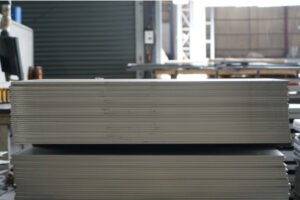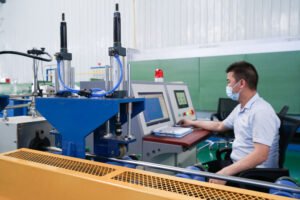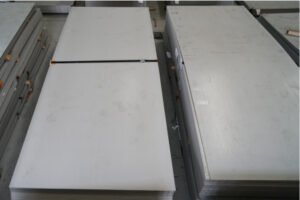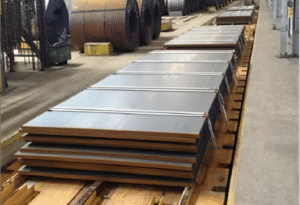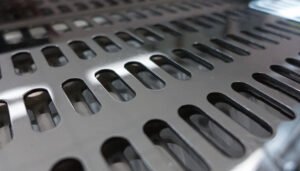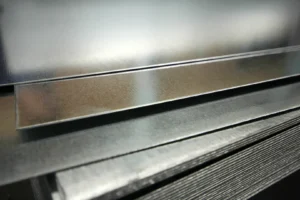Оценка жизненного цикла: Углеродный след производства листов из нержавеющей стали
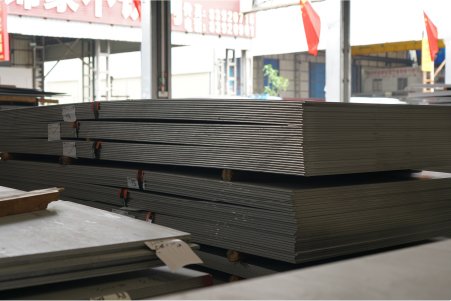
Вы сталкиваетесь с растущим давлением, требующим продемонстрировать устойчивое развитие вашей цепи поставок? Это сложный мир, где воздействие материалов на окружающую среду находится под пристальным вниманием, но найти четкие и достоверные данные может показаться невозможным. Используя оценку жизненного цикла (LCA), вы сможете прорваться сквозь шум и количественно оценить углеродный след ваших материалов, превратив устойчивость в измеримое конкурентное преимущество.
Оценка жизненного цикла (LCA) листа из нержавеющей стали - это комплексная методология, используемая для оценки воздействия на окружающую среду на всех этапах его эксплуатации. Этот анализ "от колыбели до могилы" или "от колыбели до ворот" позволяет количественно оценить затраты энергии и материалов и выбросы в окружающую среду, в результате чего получается четкий показатель углеродного следа.
Понимание этого следа больше не является академическим занятием, это стратегический императив. Будучи директором по глобальному бизнесу в компании MFY, я на собственном опыте убедился, что компании, которые активно управляют своим воздействием на окружающую среду, получают преимущество. Этот анализ проводится не только для того, чтобы соответствовать требованиям, но и для того, чтобы выявить скрытую неэффективность, обезопасить свою цепочку поставок от будущих налогов на выбросы углекислого газа и создать бренд, который найдет отклик у нового поколения сознательных клиентов. Результаты LCA могут по-настоящему удивить, показав, что не вся нержавеющая сталь создана одинаковой.
Продвижение к такому уровню прозрачности идет со всех сторон. В Европе такие механизмы, как Механизм пограничной корректировки углеродных выбросов (CBAM)1 уже меняют финансовые расчеты в международной торговле. Инвесторы все чаще проверяют надежность экологических, социальных и управленческих показателей (ESG), делая низкоуглеродную цепочку поставок обязательным условием для привлечения капитала. Мы в MFY рассматриваем это не как бремя, а как возможность продемонстрировать эффективность нашей интегрированной цепочки поставок. Контролируя все этапы - от торговли сырьем до конечной обработки - мы можем лучше измерять, управлять и в конечном итоге минимизировать воздействие на окружающую среду, предоставляя нашим клиентам данные и продукты, необходимые им для процветания в условиях низкоуглеродной экономики.
Какова методология оценки жизненного цикла для оценки производства листов из нержавеющей стали?
Знакомство с миром отчетности в области устойчивого развития может показаться изучением нового языка, наполненного аббревиатурами и сложными понятиями. Вы слышите такие термины, как "оценка жизненного цикла", и боитесь запутаться в технических деталях. Хорошая новость заключается в том, что основная концепция проста: она заключается в том, чтобы рассказать полную историю экологического путешествия продукта от начала до конца.
Методология оценки жизненного цикла (LCA) для производства листов из нержавеющей стали соответствует стандартам ISO 14040, систематически оценивая воздействие на окружающую среду на ключевых этапах. К ним относятся добыча сырья (например, железной руды, хрома, никеля), производство (плавка, литье, прокатка), распределение, этап потенциального использования и конец срока службы (переработка или утилизация).
Внедрение системы LCA - это не просто требование к отчетности, это мощный стратегический инструмент. В течение многих лет я и моя команда работали с инженерными подрядчиками, которые были мастерами по эффективности проектов на месте, но при этом не замечали воплощенного углерода своих материалов. Когда мы начали составлять для них карты этапов жизненного цикла, это было похоже на включение света в темной комнате. Они вдруг увидели конкретные "горячие точки" в своей цепочке поставок, которые увеличивали их углеродный след. Такое понимание позволяет принимать целенаправленные меры, будь то выбор материала с более высоким содержанием вторичной переработки, оптимизация логистики или сотрудничество с поставщиками, которые активно занимаются декарбонизацией своих операций. Это превращает расплывчатую цель "быть устойчивым" в конкретный план действий, позволяя вам принимать решения, которые являются одновременно экологически и экономически обоснованными. Такое изменение перспективы крайне важно для любого бизнеса, стремящегося повысить устойчивость и сохранить конкурентные преимущества на мировом рынке, который становится все более экологически сознательным. Методология предоставляет вам карту, необходимую для того, чтобы пройти путь к истинной устойчивости.
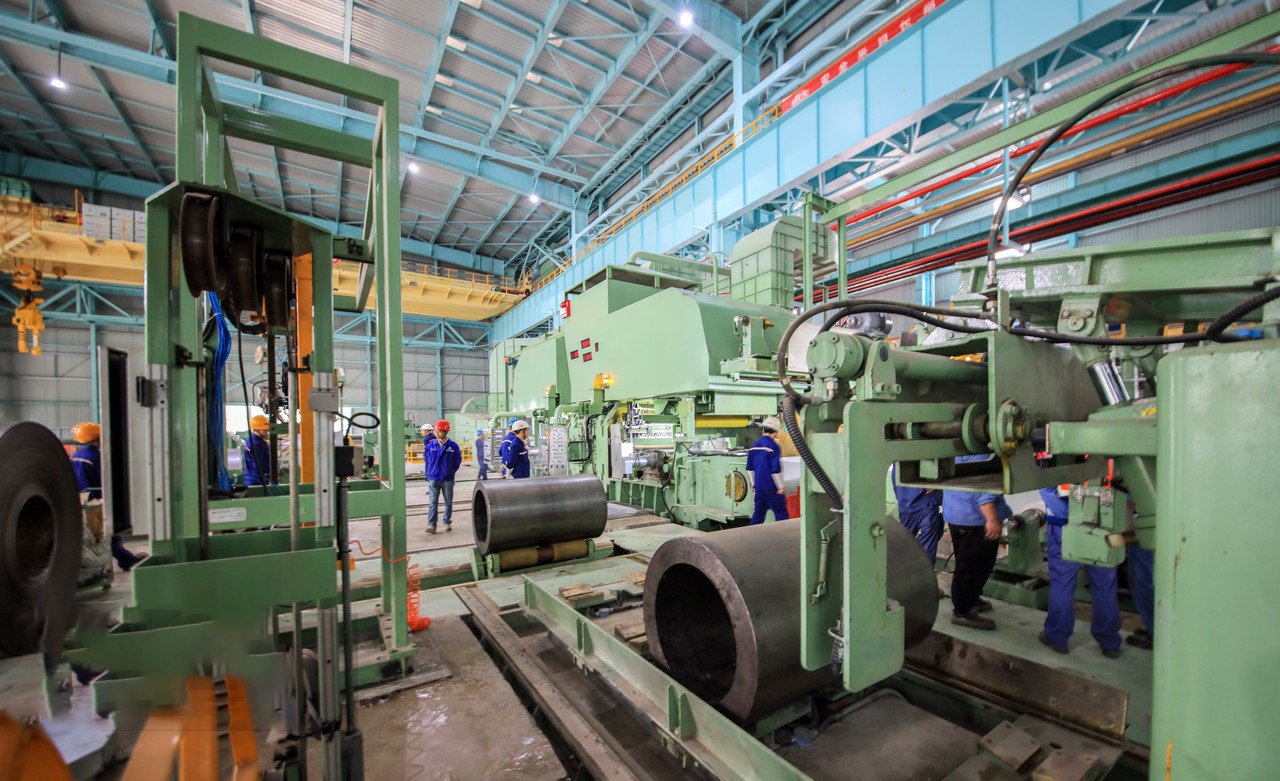
Деконструкция процесса: Границы системы от "колыбели до ворот"
Когда мы проводим LCA, первым и самым важным шагом является определение "границ системы". Для большинства наших клиентов, работающих в сфере производства и строительства, наиболее актуальной является граница "от колыбели до ворот". Эта граница включает в себя все виды деятельности от добычи сырья из земли (колыбель) до того момента, когда готовый лист нержавеющей стали покидает ворота нашего завода. Это всеобъемлющий взгляд на углеродный след от производства, предоставляющий данные, необходимые для расчета общего количества воплощенного углерода в проекте.
Этот рубеж охватывает несколько энергоемких этапов. Она начинается с добычи железной руды, хрома и никеля, а также с их последующей переработки в пригодные для использования формы, такие как ферросплавы. Затем идет основной процесс производства - в кислородной печи (BOF) или электродуговой печи (EAF), затем рафинирование, литье и, наконец, горячая и холодная прокатка, в результате которых получается конечный листовой продукт. По данным World Steel Association, на производство сырья и сам процесс выплавки стали приходится более 90% общей энергии, потребляемой в этом цикле "от колыбели до ворот".
Понимание этой границы жизненно важно для проведения справедливых сравнений. Поставщик может заявить о низком углеродном следе, но если в его оценке не учитывается влияние источников сырья или транспортировки, то данные вводят в заблуждение. В компании MFY интегрированная цепочка поставок дает нам уникальное преимущество при сборе данных. Поскольку мы управляем торговлей и переработкой сырья, мы можем собирать первичные, реальные данные по нашим операциям, а не полагаться на общие средние показатели по отрасли. Это позволяет нам предоставлять нашим партнерам гораздо более точные и достоверные данные об углеродном следе для их конкретного продукта.
Проблема данных: Первичные и вторичные данные и влияние распределения
Достоверность любого LCA зависит от качества используемых данных. Мы классифицируем данные на два типа: первичные и вторичные. Первичные данные собираются непосредственно у источника - например, точные данные о потреблении электроэнергии на наших станах холодной прокатки или о топливе, используемом нашим логистическим парком. Вторичные данные берутся из отраслевых баз данных (например, Ecoinvent или GaBi), научных исследований и правительственных отчетов. Хотя вторичные данные важны для моделирования процессов, находящихся вне нашего непосредственного контроля, например, добычи никеля в другой стране, мы всегда стремимся максимально использовать первичные данные для достижения непревзойденной точности.
Важнейшим и часто обсуждаемым аспектом LCA является "распределение". При производстве стали часто образуются побочные продукты, такие как шлак, используемый для производства цемента, или газы, которые могут быть использованы для выработки электроэнергии. Возникает вопрос: как распределить экологическую нагрузку и выгоду от основного процесса между этими различными продуктами? Выбранный метод может существенно изменить конечный углеродный след, который будет нанесен стальному листу. Например, экономическое распределение (на основе рыночной стоимости) и массовое распределение (на основе веса) могут дать разные результаты.
Вот почему так важна прозрачность методологии. Когда клиент получает экологическую декларацию продукции (EPD) для изделий из нержавеющей стали, важно проанализировать лежащие в ее основе предположения. Я вспоминаю случай с крупным интегратором оборудования, который сравнивал двух поставщиков. Оказалось, что один из них имеет гораздо меньший углеродный след, но при более глубоком изучении выяснилось, что они использовали очень выгодный метод распределения, который относил значительную часть их выбросов на счет малоценного сопутствующего продукта. Знание этих нюансов - ключ к подлинной стратегии устойчивого развития.
| Метод распределения | Описание | Влияние на площадь, занимаемую нержавеющей сталью |
|---|---|---|
| Массовое распределение | Нагрузка на окружающую среду распределяется в зависимости от массы побочных продуктов. | Как правило, на сталь возлагается большее бремя, поскольку она является основным, самым тяжелым продуктом. |
| Экономическое распределение | Бремя распределяется в зависимости от относительной рыночной стоимости субпродуктов. | Может снизить воздействие стали на окружающую среду, если побочные продукты (например, шлак, некоторые газы) имеют высокую ценность. |
| Расширение системы | Граница расширяется и включает альтернативное производство сопутствующего продукта, что позволяет избежать распределения. | Считается наиболее полным, но при этом является самым сложным и требующим большого объема данных методом. |
Функциональная единица: Обеспечение сравнения "яблоко к яблоку
Наконец, для сравнения различных продуктов в LCA должна использоваться четко определенная "функциональная единица". Это эталон, с которым соотносятся все входы и выходы. Для листов из нержавеющей стали типичной функциональной единицей является "производство одной метрической тонны листа из нержавеющей стали марки 304 толщиной 1,5 мм". Без такого точного определения сравнения бессмысленны.
Выбор функциональной единицы гарантирует, что мы сравниваем эквивалентные продукты с точки зрения полезности. Например, сравнение углеродного следа одной тонны нержавеющей стали и одной тонны алюминия не будет справедливым, если для конкретного применения вам потребуется только полтонны алюминия для достижения той же структурной прочности, что и одна тонна стали. Оценка должна быть привязана к функции, которую будет выполнять материал.
В компании MFY мы тесно сотрудничаем с нашими клиентами, чтобы понять специфику их применения. Это позволяет нам представить результаты LCA в том контексте, который для них наиболее важен. Для строительного подрядчика функциональной единицей может быть "количество нержавеющей стали, необходимое для 100 квадратных метров облицовки фасада". Для производителя это может быть "материал, необходимый для производства 1 000 единиц определенного компонента". Такой подход, ориентированный на конкретное применение, позволяет выйти за рамки общих данных о материалах и перейти к совместному решению проблем для создания действительно устойчивых конечных продуктов.
LCA соответствует стандартам ISO 14040Правда
Методология оценки жизненного цикла производства листов из нержавеющей стали стандартизирована в соответствии с ISO 14040, что обеспечивает последовательную оценку воздействия на окружающую среду на всех этапах.
Вся нержавеющая сталь имеет одинаковый углеродный следЛожь
Углеродный след значительно варьируется в зависимости от методов производства (конвертерное и электродуговое), содержания вторичного сырья и методов распределения - некоторые марки могут иметь выбросы 40% ниже, чем другие.
Насколько значительным является углеродный след при производстве листов из нержавеющей стали?
Вы привержены идее устойчивого развития, но чтобы добиться значительного прогресса, вам нужны конкретные цифры. Какова фактическая стоимость выбросов углекислого газа в нержавеющая сталь2 вы используете? Это важный вопрос, но ответ на него часто скрыт в сложных отчетах. Правда в том, что углеродный след нержавеющей стали может сильно различаться, и использование общего среднего показателя по отрасли может скрыть значительные риски и возможности в вашей цепочке поставок.
Углеродный след производства листов из нержавеющей стали весьма значителен и обычно составляет от 1,5 до 7,0 тонн CO₂-эквивалента на тонну стали. Широкий разброс в основном обусловлен методом производства (EAF на основе лома против конвертерного производства на основе руды) и углеродоемкостью используемой электроэнергии.
Эта разница - не просто сноска, это целая история. Однажды я работал с клиентом, крупным строительным подрядчиком в Юго-Восточной Азии, который участвовал в тендере на реализацию знакового проекта по строительству экологически чистого здания. Они всегда выбирали сталь, исходя из цены и доступности. Когда мы представили им LCA, сравнивающий два потенциальных источника, они были потрясены. У одного из поставщиков, использующего технологию EAF с высоким содержанием вторичного сырья и питающегося от экологически чистой энергосистемы, углеродный след был почти на 60% ниже, чем у другого, использующего более традиционный конвертерный способ производства. Эти данные не просто помогли компании выиграть тендер, они в корне изменили ее стратегию закупок. Они поняли, что экологически безопасное производство - это не затраты, а инвестиции в репутацию бренда и защита бизнеса на будущее от углеродных нормативов. Это подчеркивает важный момент: выбор поставщика - один из самых значительных рычагов, которыми вы располагаете для сокращения выбросов в 3-й области.

Великий разрыв: Электродуговая печь (EAF) против основной кислородной печи (BOF)
Самым главным фактором, определяющим углеродный след нержавеющей стали, является способ производства. В мировой сталелитейной промышленности доминируют два метода: Печь с основным кислородом (BOF)3 и электродуговая печь (EAF). Конвертерный способ производства - это первичный способ производства, то есть создание новой стали из сырья. Он включает в себя выплавку железной руды с коксом (разновидность угля) в доменной печи - процесс, который по своей сути является углеродоемким. В среднем конвертерное производство может выбрасывать в атмосферу до 2,2 тонны CO₂ на каждую тонну произведенной стали.
В отличие от него, технология EAF - это, прежде всего, метод вторичной переработки. В нем используется высоковольтное электричество для переплавки стального лома, что позволяет дать новой жизни существующей стали. Поскольку при этом не требуется добывать и плавить первичную железную руду, углеродный след значительно ниже. При использовании лома 100% и питании от низкоуглеродного источника электроэнергии углеродный след типичной EAF, производящей нержавеющую сталь, может составлять всего 0,5 тонны CO₂ на тонну стали. Большая часть нержавеющей стали в мире, особенно аустенитных марок, таких как 304 и 316, производится методом EAF, что является значительным преимуществом для устойчивого развития отрасли.
Для наших клиентов это различие имеет решающее значение. Например, производитель промышленного оборудования может обнаружить, что простой переход от поставщика с преобладанием конвертерного производства к поставщику с преобладанием EAF, такому как MFY, может в одиночку достичь их годовых целей по сокращению выбросов углерода в сырье. Это убедительная иллюстрация того, что устойчивое развитие тесно связано с технологическими решениями, принимаемыми на самых верхних этапах цепочки поставок. Мы предоставляем нашим клиентам четкую документацию по производственному процессу на основе EAF, что дает им уверенность и данные для обоснования их собственных "зеленых" заслуг.
Сила лома: Раскрытие ценности циркулярной экономики
Высокая способность нержавеющей стали к вторичной переработке является ее главным экологическим преимуществом. Каждая тонна стального лома, используемая в EAF, заменяет эквивалентное количество первичного материала, позволяя избежать сопутствующих выбросов при добыче, транспортировке и выплавке. Взаимосвязь очевидна: больше лома - меньше углерода. Согласно исследованию Международного форума нержавеющей стали (ISSF), использование одной тонны лома нержавеющей стали экономит примерно 4,3 тонны CO₂, если учесть экономию энергии и выбросов в процессе производства.
Содержание вторичного сырья в нержавеющей стали может быть разным. В среднем в новых изделиях из нержавеющей стали содержание вторичного сырья составляет около 60%. Однако этот показатель может быть значительно выше. В компании MFY доступ к надежным поставкам высококачественного лома через нашу интегрированную сеть торговли и переработки позволяет нам устанавливать и достигать уровня содержания вторичного сырья в некоторых видах продукции до 85-90%. Это является ключевой частью нашей стратегии декарбонизации и прямой выгодой, которую мы передаем нашим клиентам.
Рассмотрим дистрибьютора, который поставляет листы из нержавеющей стали различным малым и средним предприятиям. Сотрудничая с MFY и поставляя продукцию с подтвержденным высоким содержанием вторичной переработки, они обеспечивают своим клиентам конкурентное преимущество. Их клиенты, в свою очередь, могут использовать эту информацию в своем маркетинге и отчетности, создавая эффект устойчивости по всей цепочке создания стоимости. Это демонстрирует, что круговая экономика - не просто абстрактная концепция, а практическая бизнес-модель, обеспечивающая ощутимые экологические и коммерческие преимущества.
Не все электроны зеленые: Критическое влияние энергетического баланса
Хотя процесс EAF по своей сути менее углеродоемкий, чем конвертерный, его конечный след все равно в значительной степени зависит от источника электроэнергии. EAF - это колоссальный потребитель электроэнергии, и если эта электроэнергия поступает с угольной электростанции, то конечный продукт все равно будет иметь значительный углеродный след. Этот фактор вносит региональные различия в уравнение выбросов углерода. Сталелитейный завод в регионе, богатом гидроэнергетикой или атомной энергией, будет производить гораздо менее углеродный продукт, чем аналогичный завод в регионе, питающемся преимущественно ископаемым топливом.
Это критический момент анализа для глобальных цепочек поставок. Компания может поставлять продукцию с завода EAF, считая его "зеленым" вариантом, но если этот завод находится в сети с высоким содержанием углерода, выгода будет незначительной. Углеродоемкость электросети, измеряемая в граммах CO₂e на киловатт-час (gCO₂e/kWh), может варьироваться от менее 50 в таких местах, как Франция или Швеция, до более 600 в регионах с высоким содержанием угля. Это может изменить конечный углеродный след одной и той же стали, произведенной на EAF, более чем на 0,5 тонны CO₂ на тонну продукции.
| Источник энергии | Типичная углеродоемкость (гCO₂e/кВт-ч) | Влияние на стальной след EAF |
|---|---|---|
| Уголь | 900 - 1,200 | Очень высокий |
| Природный газ | 400 - 550 | Средний |
| Солнечная фотоэлектрическая батарея | 20 - 80 | Очень низкий |
| Ветер | 10 - 25 | Очень низкий |
| Гидроэнергетика | 5 - 20 | Очень низкий |
Мы в MFY прекрасно понимаем эту проблему. В рамках нашего стремления к постоянному развитию мы активно изучаем стратегии по декарбонизации энергоснабжения. Это включает в себя изучение долгосрочных соглашений о покупке электроэнергии (PPA) с поставщиками возобновляемых источников энергии и инвестирование в меры по повышению энергоэффективности на местах для снижения общего потребления. Мы считаем, что истинная устойчивость требует не только как вы производите, но и то, что вы использовать производить.
Сталь EAF имеет меньший углеродный следПравда
Производство в электродуговой печи с использованием стального лома обычно выбрасывает 0,5 тонны CO₂ на тонну, что значительно меньше, чем при конвертерном способе.
Вся сталь EAF одинаково экологичнаЛожь
Углеродный след EAF варьируется на 500% в зависимости от источника электроэнергии - EAF на угле может превышать 2,5 тонны CO₂/тонну.
Каковы основные факторы, способствующие выбросам углерода при производстве листов из нержавеющей стали?
Вы знаете, что след от выбросов значительный, но чтобы его сократить, нужно знать, откуда он берется. Пытаться сократить выбросы, не имея четкого представления о ключевых факторах, все равно что ориентироваться без компаса. Выявление конкретных "горячих точек" углерода в производственном процессе - единственный способ разработать эффективную и действенную стратегию декарбонизации.
Основными факторами, определяющими выбросы углерода при производстве листовой нержавеющей стали, являются огромный расход энергии на плавку и рафинирование, содержание углерода в сырье, таком как ферросплавы и никель, а также выбор технологии производства - в частности, использование углерода в качестве химического восстановителя.
Эти факторы представляют собой основные проблемы, которые мы должны решить как отрасль. Для каждого клиента, с которым я работаю, от крупных производителей до специализированных инжиниринговых компаний, путь начинается с этого диагноза. Разбив общий углеродный след на составные части, мы можем перейти от общего понимания проблемы к целенаправленному, основанному на данных плану действий. Речь идет о том, чтобы направить наши усилия туда, где они окажут наибольшее влияние. Например, повышение эффективности печей может принести гораздо больше результатов, чем незначительные изменения в логистике. Такое детальное понимание является основой надежной и действенной программы устойчивого развития.
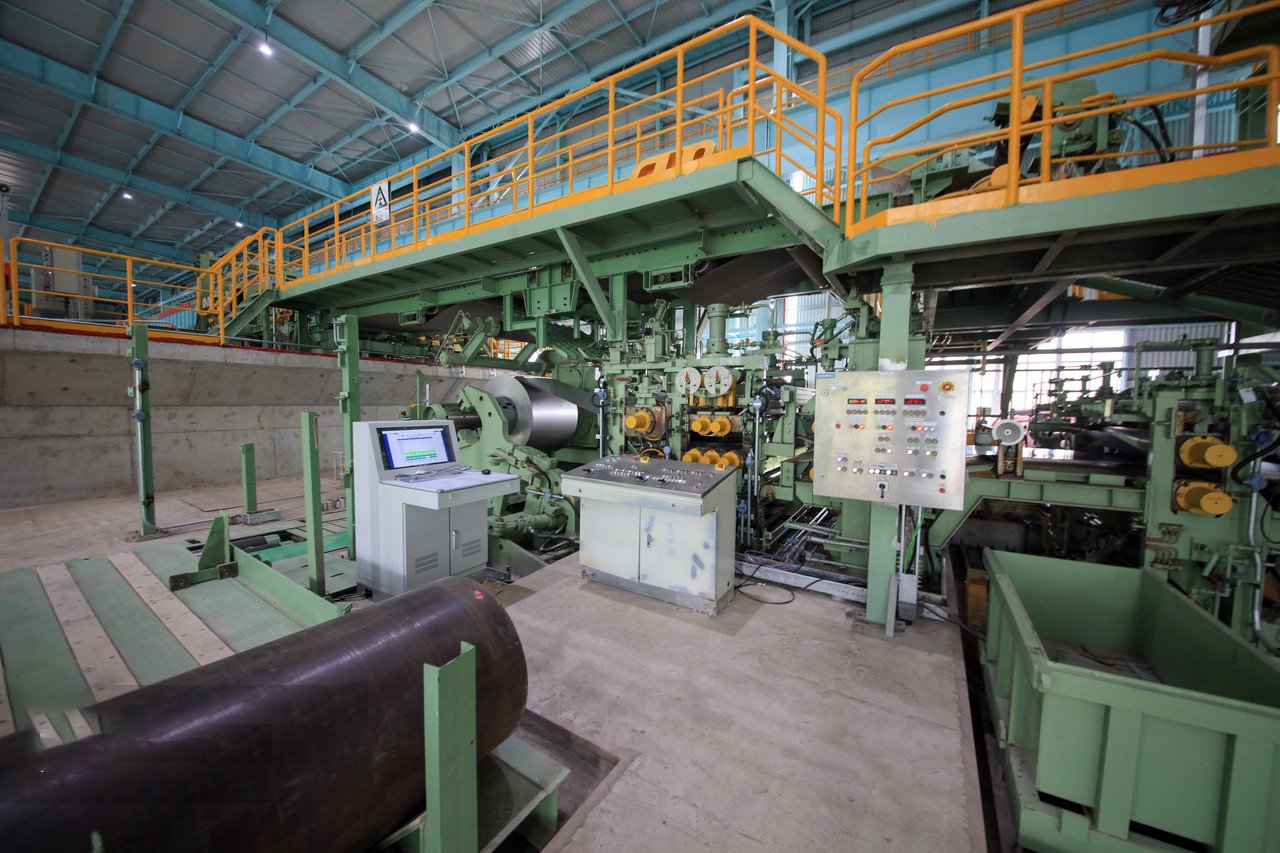
Энергетический зверь: Плавление, рафинирование и прокатка
Сердце производства нержавеющей стали - печь, а она является ненасытным потребителем энергии. В электродуговой печи (EAF) электричество используется для генерации дуги, которая достигает температуры более 1 650°C (3 000°F) для расплавления лома и сплавов. Современная дуговая печь может потреблять от 400 до 500 киловатт-часов (кВт/ч) электроэнергии для производства одной тонны жидкой стали. Это потребление электроэнергии является самым большим вкладом в углеродный след предприятия EAF, и его влияние напрямую связано с углеродоемкость местной энергосистемы4Как мы уже обсуждали.
После первоначальной плавки сталь подвергается дальнейшему рафинированию в таких процессах, как аргонокислородное обезуглероживание (AOD). Процесс AOD имеет решающее значение для достижения точного химического состава и низкого содержания углерода, необходимого для нержавеющей стали. Однако при этом расходуется значительное количество аргона, кислорода и азота, а также образуются прямые выбросы CO₂, поскольку углерод удаляется из расплавленной стали. На эту стадию рафинирования может приходиться 15-20% от общего объема выбросов.
Наконец, затвердевший стальной сляб проходит через станы горячей и холодной прокатки для достижения необходимой толщины и качества поверхности конечного листового продукта. Эти прокатные операции также являются весьма энергоемкими, требующими огромных механических усилий и часто повторных нагревательных печей для поддержания ковкости стали. Хотя эти операции не столь энергоемки, как первоначальная плавка, суммарная энергия, используемая на этих этапах отделки, весьма значительна. Компания MFY уделяет особое внимание современным энергоэффективным прокатным станам и оптимизации процессов - это ключевая часть нашей стратегии по минимизации этого компонента углеродного следа.
Воплощенный углерод сырьевых материалов и сплавов
Хотя потребление энергии является наиболее заметным фактором, мы не можем игнорировать "воплощенный" углерод в самом сырье. Нержавеющая сталь - это сплав, и ее уникальные свойства обусловлены добавлением таких элементов, как хром и никель. Добыча и обработка этих материалов требуют больших затрат энергии и несут значительный углеродный след задолго до того, как они попадают на наш сталелитейный завод.
Феррохром, сплав, придающий коррозионную стойкость, является ярким примером. Его производство в дуговых печах под флюсом - чрезвычайно энергоемкий процесс. При производстве одной тонны феррохрома выбрасывается от 2 до 4 тонн CO₂. Аналогичным образом, никель, обеспечивающий прочность и пластичность, имеет сложный и энергоемкий процесс добычи и выплавки. Углеродный след никеля может сильно варьироваться в зависимости от типа руды и метода переработки, составляя от 10 до более 40 тонн CO₂ на тонну никеля.
Именно здесь интегрированная цепочка поставок и ответственный подход к выбору поставщиков приобретают решающее значение. Как компания, торгующая сырьем, MFY имеет возможность контролировать процесс получения наших сплавов. У нас есть возможность сотрудничать с производителями первичных металлов, которые активно работают над декарбонизацией своих производств, например, используя гидроэлектроэнергию для своих плавильных заводов. Для наших клиентов это означает, что нержавеющая сталь, которую они получают от нас, имеет более низкий "унаследованный" углеродный след от входящих в ее состав материалов - фактор, который часто упускается из виду при менее сложных методах учета углерода.
Транспорт и логистика: След глобальной цепи поставок
Хотя сам процесс производства доминирует в углеродном следе, выбросы от транспортировки и логистики не являются незначительными, особенно в глобализированной отрасли. Производство нержавеющей стали включает в себя несколько этапов: доставку сырья, такого как лом и сплавы, на завод, а затем транспортировку готовых листов нашим клиентам на таких рынках, как Индия, Юго-Восточная Азия и Ближний Восток. Каждый этап этого путешествия добавляет к итоговому показателю углерода.
Вид транспорта имеет существенное значение. Океанские перевозки - основа международной торговли - являются наиболее углеродоэффективным видом транспорта на большие расстояния, измеряемые в граммах CO₂ на тонно-километр. Железнодорожные перевозки также относительно эффективны, в то время как автомобильные перевозки являются самыми углеродоемкими. При перевозке груза с нашего предприятия в Китае в порт Мумбаи (Индия) выбор между различными маршрутами транспортировки и эффективностью судов может изменить логистический след.
| Режим транспортировки | Типичные выбросы CO₂ (г/т-км) | Пример использования |
|---|---|---|
| Океанский фрахт (перевозка насыпью) | 5 - 15 | Международные перевозки рулонов и листов |
| Железнодорожные грузоперевозки | 15 - 30 | Междугородние внутренние или континентальные перевозки |
| Автомобильные грузоперевозки (тяжелые грузовики) | 50 - 150 | Доставка "последней мили" от порта/склада до объекта клиента |
Компания MFY использует наши цифровые инновационные возможности для оптимизации логистики. Это включает в себя консолидацию грузов для обеспечения полной загрузки контейнеров, планирование маршрутов для минимизации расстояний и партнерство с логистическими провайдерами, которые инвестируют в более экономичный автопарк. Для строительного подрядчика, работающего в сжатые сроки, скорость доставки имеет решающее значение, но мы работаем с ним, чтобы найти баланс, часто показывая, как чуть более длительное морское путешествие может привести к значительной экономии углерода по сравнению с более ускоренными мультимодальными вариантами. Это часть целостного подхода к декарбонизации, который учитывает каждый шаг от шахты до конечного потребителя.
ЭАФ потребляет 400-500 кВт-ч на тоннуПравда
Современные дуговые электропечи требуют 400-500 кВт/ч электроэнергии для выплавки одной тонны стали, что делает энергию самым крупным источником выбросов.
Феррохром выбрасывает 2-4 т CO₂ на тоннуЛожь
Производство феррохрома на самом деле выбрасывает 2-4 тонны CO₂ на тонну произведенной продукции, а не на тонну нержавеющей стали, как это подразумевается.
Какие стратегии могут быть приняты для снижения углеродного следа при производстве листов из нержавеющей стали?
Задача декарбонизации может показаться грандиозной, поэтому многие компании задаются вопросом, с чего начать. Чувство подавленности масштабами проблемы может привести к бездействию. Но на самом деле существует четкая, многогранная стратегия, предлагающая практический путь к низкоуглеродному будущему для стали. Речь идет об осознанном выборе, начиная с используемых материалов и заканчивая потребляемой энергией.
Для эффективного снижения "углеродного следа" производства листов из нержавеющей стали необходима стратегия, состоящая из трех составляющих: максимальное использование лома в качестве сырья, активное стремление к энергоэффективности и переходу на возобновляемые источники энергии, а также инвестиции в прорывные технологии низкоуглеродного производства.
Эта стратегическая дорожная карта превращает проблему в набор управляемых решений. За годы работы я провел через этот путь множество клиентов, в том числе известного производителя оборудования на Ближнем Востоке. Они начали с простой цели: снизить уровень воплощенного углерода в своей продукции. Мы начали с того, что перевели их спецификации на нашу сталь с самым высоким содержанием вторичного сырья. Затем мы предоставили им документы EPD, подтверждающие наши собственные инвестиции в энергоэффективность. Теперь мы ведем активный диалог о будущих продуктах, изготовленных с использованием еще более совершенных низкоуглеродных технологий. Такой поэтапный подход делает декарбонизацию достижимой. Это путь непрерывного совершенствования, а не один невозможный скачок. Сосредоточившись на этих ключевых стратегиях, мы сможем коллективно добиться значительных изменений во всей отрасли.

Воплощая кругооборот: Центральная роль стального лома
Самой непосредственной и действенной стратегией декарбонизации производства нержавеющей стали является максимальное использование металлолом5. Как уже говорилось, технология электродуговой печи, которая работает на ломе, по своей сути имеет более низкий уровень выбросов, чем конвертерная технология на основе руды. Поэтому краеугольным камнем любой низкоуглеродной стратегии является подача на EAF как можно большего количества высококачественного лома. Такой подход является воплощением циркулярной экономики, превращая отходы в ценный ресурс и значительно снижая потребность в добыче первичных материалов и связанное с этим воздействие на окружающую среду.
Выгоды поддаются количественной оценке и являются существенными. Согласно отраслевым данным, каждое увеличение на 10% общего соотношения лома и руды при производстве стали может привести к сокращению примерно на 150-200 кг CO₂ на тонну стали. Для такой компании, как MFY, которая работает в рамках EAF, оптимизация цепочки поставок лома является одним из главных приоритетов. Наш диверсифицированный бизнес, включающий торговлю сырьем, дает нам преимущество в поиске, сортировке и переработке различных сортов лома для обеспечения оптимального питания наших печей.
Эта приверженность принципу циркулярности распространяется и на наши отношения с клиентами. Недавно мы сотрудничали с крупной производственной компанией, которая перепроектировала свою продукцию, чтобы облегчить ее разборку после окончания срока службы. Таким образом, из старых изделий можно было извлекать чистый высококачественный лом нержавеющей стали, который мы затем забирали и использовали для производства новых листов. Это позволило создать замкнутую систему, которая минимизировала отходы, снизила затраты на сырье и значительно уменьшила углеродный след всего жизненного цикла продукции. Это яркий пример того, как сотрудничество между поставщиком и клиентом может ускорить переход к циркулярной экономике.
Двойные столпы: Энергоэффективность и закупки "зеленой" энергии
Помимо сырья, еще одним важным рубежом декарбонизации является энергетика. Это предполагает два подхода: использование меньшего количества энергии в целом (эффективность) и обеспечение чистоты используемой энергии (закупки). Энергоэффективность заключается в постоянном совершенствовании производства. Это может варьироваться от установки системы рекуперации отработанного тепла6 которые улавливают тепло из отходящих газов печи для обеспечения энергией других частей завода, до модернизации двигателей с частотно-регулируемыми приводами и внедрения передового программного обеспечения для управления технологическим процессом для оптимизации работы печи в режиме реального времени.
Эти меры, хотя иногда и требуют предварительных инвестиций, приносят прямую прибыль за счет снижения эксплуатационных расходов и сокращения выбросов. Например, современная система рекуперации отработанного тепла может снизить общую потребность завода в энергии на 10-15%, что является значительной экономией как средств, так и углерода. В компании MFY мы придерживаемся принципа "непрерывного развития", который заставляет нас постоянно искать и внедрять такие системы повышения эффективности на наших производственных предприятиях.
Однако одной эффективности недостаточно. Конечная цель - обеспечить нашу деятельность энергией, не содержащей углерода. Именно здесь закупка экологически чистой энергии7 поступает. Самый прямой путь к этому - долгосрочные соглашения о покупке электроэнергии (PPA) с разработчиками солнечных или ветряных электростанций. PPA обеспечивает стабильные поставки электроэнергии из возобновляемых источников по фиксированной цене, избавляя нашу деятельность от рисков, связанных с нестабильностью рынков ископаемого топлива, и напрямую сокращая выбросы по Scope 2. Сталелитейный завод, который имеет предсказуемый и высокий спрос на электроэнергию, может стать идеальным якорным клиентом для нового проекта по возобновляемой энергетике, помогая ускорить "зеленый" переход для всей региональной сети.
Следующий рубеж: инвестиции в прорывные технологии
Хотя лом и чистая энергия - это рабочие лошадки декарбонизации сегодня, мы также должны обратить внимание на прорывные технологии, которые определят будущее низкоуглеродистой стали. Промышленность активно исследует и разрабатывает несколько перспективных путей, которые могут практически полностью исключить выбросы CO₂ в процессе выплавки стали. Эти инновации представляют собой долгосрочное решение для производства огромных объемов стали, необходимых миру для устойчивого будущего.
Одна из самых интересных разработок - использование зелёный водород8. В традиционной доменной печи кокс (уголь) выступает в качестве "восстановителя", удаляя кислород из железной руды, но выделяя при этом CO₂. Вместо этого в качестве чистого восстановителя можно использовать "зеленый" водород, получаемый путем расщепления воды с помощью возобновляемой электроэнергии, при этом единственным побочным продуктом является вода (H₂O). Эта технология, известная как прямое восстановление железа (DRI) с использованием водорода, способна устранить подавляющее большинство технологических выбросов при производстве первичной стали.
Другой важнейшей технологией является Улавливание, использование и хранение углерода (CCUS)9. В тех процессах, где полностью устранить выбросы сложно, технология CCUS позволяет улавливать CO₂ из дымовых газов, предотвращая его попадание в атмосферу. Уловленный CO₂ может быть надежно сохранен под землей в геологических формациях или "утилизирован" в качестве сырья для производства других продуктов, например, топлива или строительных материалов. Несмотря на то что технология CCUS еще только формируется, она представляет собой жизненно важный инструмент для борьбы с последними, труднодоступными выбросами и достижения нулевого уровня сталелитейной промышленности. Будучи компанией, ориентированной на перспективу, MFY внимательно следит за развитием этих технологий, чтобы быть готовой направлять наших клиентов и интегрировать эти решения, как только они станут коммерчески жизнеспособными.
Лом снижает выбросы сталиПравда
Использование стального лома на электролизных печах позволяет сократить выбросы CO₂ на 150-200 кг на тонну по сравнению с переработкой первичной руды.
Водород полностью заменяет коксЛожь
Несмотря на то, что "зеленый" водород перспективен в качестве восстановителя, в настоящее время в доменных печах в основном используется кокс из-за технических и экономических ограничений.
Каковы наилучшие методы устойчивого производства листов из нержавеющей стали?
Вы готовы действовать, но как на рынке, переполненном заявлениями об экологичности, определить действительно устойчивого поставщика? Многие производители говорят об устойчивом развитии, но их заявления могут быть расплывчатыми и трудно проверяемыми. Чтобы по-настоящему обезопасить свою цепочку поставок и создать надежный "зеленый" бренд, вам нужно искать конкретные доказательства и передовой опыт, которые отделяют лидеров от отстающих.
Передовые методы устойчивого развития производства листов из нержавеющей стали включают в себя приоритетное использование вторичного сырья, предоставление прозрачных, проверенных третьей стороной экологических деклараций продукции (EPD), активное использование возобновляемых источников энергии, надежное отслеживание цепочки поставок, а также формирование культуры постоянного совершенствования и инноваций.
Эти методы составляют контрольный список для любого взыскательного покупателя. Я всегда советую нашим партнерам, от дистрибьюторов до инженерных подрядчиков, не ограничиваться маркетинговыми брошюрами, а запрашивать данные. Поставщик, приверженный принципам устойчивого развития, сможет предоставить EPD на свою продукцию, подробно описать стратегию поиска источников энергии и рассказать о своей дорожной карте по декарбонизации в будущем. Выбор партнера, который воплощает в себе эти лучшие практики, - самый эффективный способ обеспечить соответствие нержавеющей стали в ваших проектах вашей собственной приверженности устойчивому будущему. Речь идет о создании партнерства, основанного на прозрачности и общих целях.
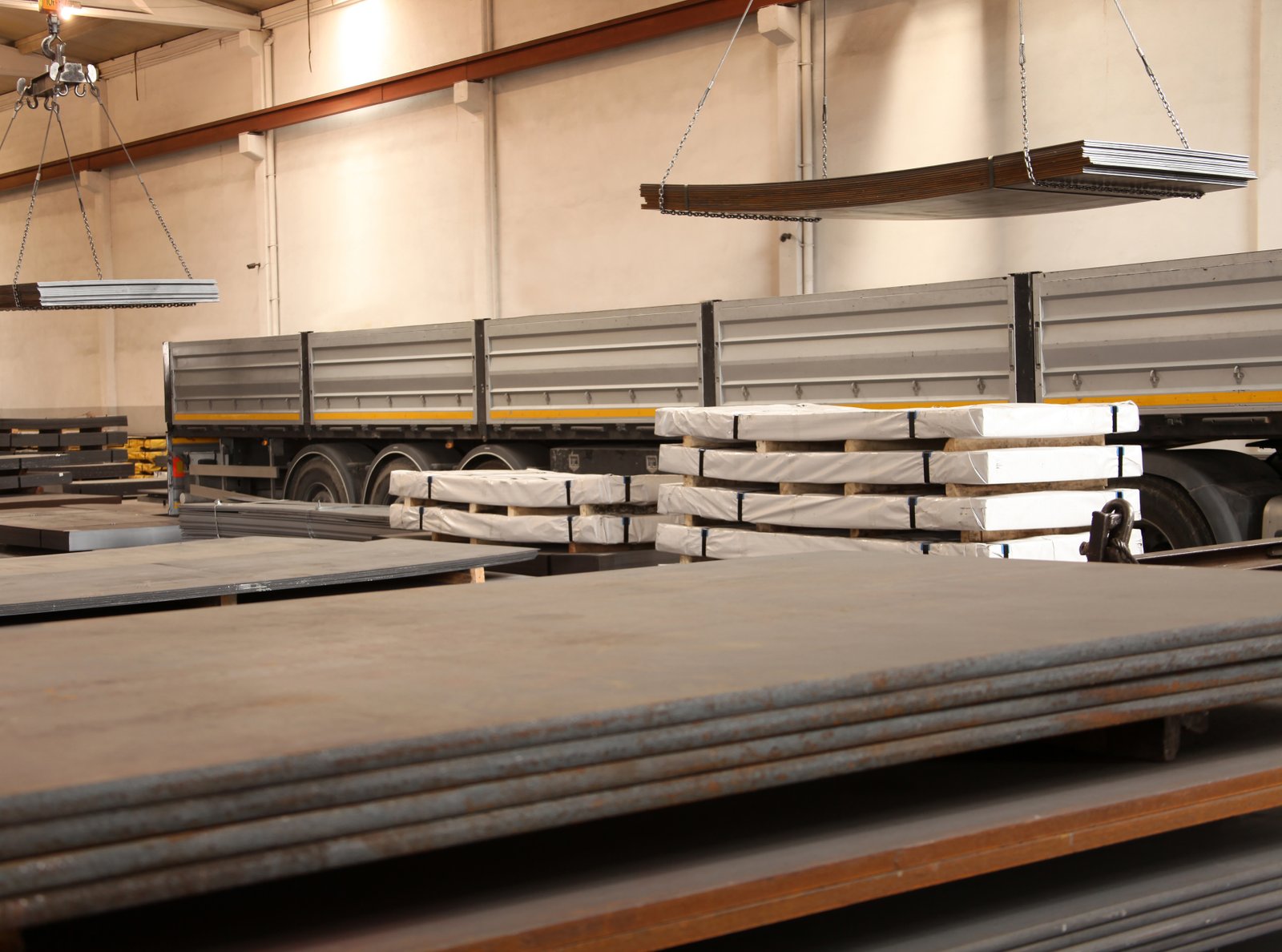
Золотой стандарт прозрачности: Экологические декларации о продукции (EPD)
В сфере устойчивых закупок экологическая декларация продукции (EPD) является золотым стандартом прозрачности. EPD - это, по сути, этикетка с информацией о воздействии продукта на окружающую среду. Это стандартизированный, проверенный третьей стороной документ, в котором данные оценки жизненного цикла (LCA) продукта представлены в понятном и сопоставимом формате. Для нержавеющей стали EPD содержит точную цифру потенциала глобального потепления (т. е. углеродного следа), а также данные о других видах воздействия на окружающую среду, таких как потребление воды и потенциал разрушения озонового слоя.
Запрос EPD у вашего поставщика - это самый эффективный способ отсечь "зеленое промывание". Расплывчатое заявление о том, что продукт является "экологически чистым" или "зеленым", не имеет смысла без подкрепления данными. EPD предоставляет такие данные, проверенные независимой третьей стороной в соответствии с международными стандартами, такими как ISO 14025. Он позволяет сравнивать продукцию разных поставщиков, что дает вам возможность принимать решение о покупке на основе подтвержденных экологических характеристик.
Я на собственном опыте убедился в силе EPD. Мы работали с международной строительной компанией, участвовавшей в тендере на проект с жесткими требованиями сертификации LEED. Их способность предоставить EPD на конкретный продукт для используемой ими нержавеющей стали MFY, а не полагаться на общие отраслевые данные, стала ключевым отличительным фактором, который помог им получить контракт. Это продемонстрировало уровень усердия и приверженности принципам устойчивого развития, что вывело их на первый план. Именно поэтому мы стремимся разрабатывать и предоставлять EPD для нашей основной продукции, поскольку считаем, что прозрачность - это основа доверия.
За пределами углерода: прослеживаемость цепочки поставок и ответственное сорсинг
Настоящая устойчивость выходит за рамки простого подсчета углерода. Лучший в своем классе поставщик должен также продемонстрировать приверженность ответственному подбору поставщиков и отслеживанию цепочки поставок. Это значит знать, откуда поступает сырье, и гарантировать, что оно добывается и обрабатывается с соблюдением экологических и социальных норм. В случае с нержавеющей сталью это подразумевает изучение практики работы шахт, где добывают никель, хром и другие необходимые сплавы.
В этой области цифровые инновации, являющиеся основной составляющей идентичности MFY, играют решающую роль. Новые технологии, такие как блокчейн, используются для создания неизменных записей о прохождении материала по цепочке поставок. Цифровая бухгалтерская книга может проследить путь партии феррохрома от плавильного завода с высокими экологическими стандартами до нашей печи и конечного листа нержавеющей стали, поставляемого клиенту. Такой уровень прослеживаемости обеспечивает беспрецедентную гарантию от таких проблем, как незаконная добыча или использование материалов от экологически безответственных производителей.
Создание по-настоящему устойчивой и этичной цепочки поставок требует более тщательного изучения. Это предполагает задавание поставщикам жестких вопросов об их политике выбора поставщиков, процессах должной проверки и взаимодействии с собственными вышестоящими поставщиками. В MFY наша интегрированная модель, сочетающая торговлю сырьем и производство, позволяет нам лучше контролировать цепочку поставок. Мы считаем своей обязанностью не только поставлять высококачественный продукт с низким уровнем выбросов углекислого газа, но и предоставлять нашим клиентам уверенность в том, что он был произведен ответственно от конца до конца.
Этос эволюции: Стремление к постоянному совершенствованию
ли, наиболее устойчивые производители - это те, кто признает, что устойчивость - это не пункт назначения, а путешествие. Передовой опыт - это не достижение какого-то одного, статичного сертификата и последующая остановка. Речь идет о формировании глубоко укоренившейся культуры постоянного совершенствования и инноваций, о постоянном поиске новых путей снижения воздействия на окружающую среду. Это одна из основных ценностей MFY, которая выражается в нашей вере в "гибкую устойчивость и непрерывную эволюцию".
Это обязательство проявляется в ощутимых формах. Это означает наличие публично заявленной дорожной карты по декарбонизации с четкими краткосрочными и долгосрочными целями. Это означает активное инвестирование части доходов в исследования и разработки, направленные на повышение эффективности процессов и внедрение новых, более экологичных технологий. Это означает активное сотрудничество с клиентами для совместного создания более устойчивых решений, будь то разработка сплава, в котором используются менее ресурсоемкие элементы, или разработка программы возврата продукции для улучшения циркулярности.
Когда вы оцениваете поставщика, обратите внимание на его перспективное мышление. Говорят ли они о том, что уже сделали, или с воодушевлением рассказывают о том, что будут делать дальше? Недавно у меня была встреча с долгосрочным партнером, дистрибьютором в Индии. Вместо того чтобы просто обсуждать цены на следующий квартал, мы провели половину встречи в мозговом штурме, обсуждая, как мы можем использовать наши общие данные для сокращения логистических выбросов и какие новые продукты с высоким содержанием вторичной переработки потребуются их рынку в ближайшие пять лет. Такова природа истинного партнерства в области устойчивого развития - партнерства, основанного на сотрудничестве, инновациях и постоянном внимании к следующему этапу пути.
EPD подтверждают заявления об устойчивом развитииПравда
Экологические декларации продукции (EPD) предоставляют проверенные третьей стороной данные о воздействии продукта на окружающую среду, что делает их надежным инструментом для оценки заявлений об устойчивом развитии.
Все EPD созданы одинаковымиЛожь
ОВОС могут различаться по объему и методологии. Комплексное УПД, охватывающее весь жизненный цикл продукта, более ценно, чем ограниченное.
Заключение
В конечном счете, понимание углеродного следа нержавеющей стали с помощью оценки жизненного цикла вносит решающую ясность. Воздействие значительно варьируется, но им можно управлять. Сокращение этого следа достижимо за счет максимального использования лома, повышения энергоэффективности и выбора партнеров, приверженных прозрачности и инновациям.
-
Узнайте о влиянии CBAM на глобальную торговлю и выбросы углекислого газа ↩
-
Понимание воздействия производства нержавеющей стали на окружающую среду ↩
-
Узнайте о различиях между конвертерным и электродуговым производством и их воздействии на окружающую среду ↩
-
Понять взаимосвязь между углеродоемкостью энергосистемы и производственными выбросами ↩
-
Узнайте об экологических преимуществах вторичной переработки металлов ↩
-
Откройте для себя энергосберегающие технологии в производстве ↩
-
Понять, как возобновляемые источники энергии влияют на углеродный след в промышленности ↩
-
Изучение инновационных технологий, снижающих выбросы углерода в сталелитейной промышленности ↩
-
Узнайте, как CCUS может сократить выбросы CO₂ в промышленности ↩
У вас есть вопросы или нужна дополнительная информация?
Свяжитесь с нами, чтобы получить индивидуальную помощь и квалифицированный совет.

